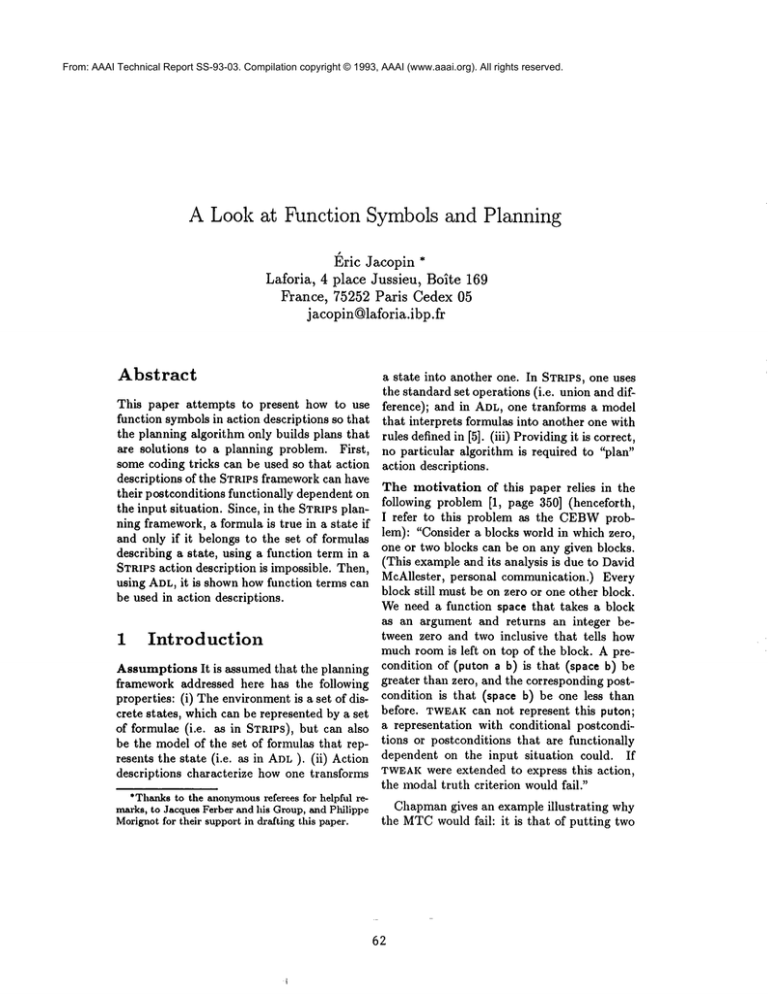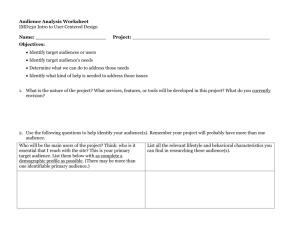
From: AAAI Technical Report SS-93-03. Compilation copyright © 1993, AAAI (www.aaai.org). All rights reserved.
A Look at Function Symbols and Planning
Eric Jacopin *
Laforia, 4 place Jussieu, Bolte 169
France, 75252 Paris Cedex 05
j acopin@lMoria.ibp.fr
Abstract
This paper attempts to present how to use
function symbols in action descriptions so that
the planning algorithm only builds plans that
are solutions to a planning problem. First,
some coding tricks can be used so that action
descriptions of the STRIPSframework can have
their postconditions functionally dependent on
the input situation. Since, in the STRIPSplanning framework, a formula is true in a state if
and only if it belongs to the set of formulas
describing a state, using a function term in a
STRIPSaction description is impossible. Then,
using ADL,it is shown how function terms can
be used in action descriptions.
a state into another one. In STRIPS, one uses
the standard set operations (i.e. union and difference); and in ADL,one tranforms a model
that interprets formulas into another one with
rules definedin [5]. (iii) Providingit is correct,
no particular algorithm is required to "plan"
action descriptions.
The motivation of this paper relies in the
following problem [1, page 350] (henceforth,
I refer to this problem as the CEBWproblem): "Consider a blocks world in which zero,
one or two blocks can be on any given blocks.
(This example and its analysis is due to David
McAllester, personal communication.) Every
block still must be on zero or one other block.
Weneed a function space that takes a block
as an argument and returns an integer between zero and two inclusive that tells how
1 Introduction
muchroom is left on top of the block. A preAssumptions It is assumed that the planning condition of (puton a b) is that (space b) be
framework addressed here has the following greater than zero, and the corresponding postproperties: (i) The environmentis a set of dis- condition is that (space b) be one less than
can not represent this puton;
crete states, which can he represented by a set before. TWEAK
a
representation
with conditional postcondiof formulae (i.e. as in STRIPS), but can also
tions
or
postconditions
that are functionally
be the model of the set of formulas that repdependent
on
the
input
situation could. If
resents the state (i.e. as in ADL). (ii) Action
were extended to express this action,
descriptions characterize how one transforms TWEAK
the modMtruth criterion would fail."
*Thanksto the anonymous
referees for helpful reChapmangives an example illustrating
why
marks,to JacquesFerber and his Group,and Philippe
Morignotfor their supportin drafting this paper.
the MTCwould fail: it is that of putting two
62
blocks on top of another one. Then, the MTC on LISP (on a is binary predicate and a and
allows the construction of plans that stack a b are constant symbols): instead of the usual
third block although there can be at most two on(a,b) writing, the TWEAK
writing is (on
blocks on top of another.
b). Finally, (-~ (on a b)) is the negation of
In this example, one wish to introduce the previous formula.
function term space. However, the TWEAK The action description for the CEBWprobrepresentation only deals with predicates. But lem looks something like this (Chapman does
as Lifschitz remarks it [4] (restriction on the not give it precisely):
definition A so any formula is an atomic forName(puton)
puton(x,y,z)
mula), a sound STRIPSsystem may use funcPre(puton)
{(on x z), (greater 0 (space
tions as parameters of predicates. So whycanAdd(puton) :
~(on x y), (subtract (spacey) 1)}
not TWEAK,
which is a sound procedure, solve
Del(puton)
~(on x z)}
the CEBWproblem? Moreover, how could
Although it is not clear how the subtract
one plan with terms only (i.e. terms not being
symbol works (according to the language it
parameters of predicates)?
Despite the general undecidability of plan- could be a predicate), the key point is the
ning with function symbols [1,3], the use of greater predicate. This predicate tests if there
function symbols in planning should be ad- is enough room on top of a block. For this to
dressed in order to answer the previous ques- be true, (space y) must either return 1 or
Consider the partially ordered plan where, in
tions.
parallel, three blocks are to be stacked on top
of a fourth one. In the initial situation, the
2 Functions
and the MTC four blocks are on top of the table and in the
final situation, three blocks are on top of the
fourth one. This plan should be rejected since
In this section, the reader must be familiar
with TWEAK’s
basic terminology.
we consider that at most two blocks can be on
This section shows that functions terms can any given blocks. But the MTCfails refusing
be used as parameters of predicates so that the the plan because stacking one block only subCEBWproblem can be solved by the MTC. tract one to space. And then the precondition
I first present the language used in TWEAK(greater 0 (space y)) of each of the three puton
(this is important since I need to extend it to of the plan can be established. Consequently,
solve the CEBWproblem), then I extend the as stated, Chapman concludes that [1, page
can not represent this puton; a
language with respect to Lifschitz’s soundness 350]: "TWEAK
[4] and finally discuss what TWEAK
can’t do. representation with conditional postconditions
or postconditions that are functionally dependent on the input situation could."
2.1
TWEAK’s language
TWEAK’Salphabet only consists of predicate symbols, constant symbols, variables, the
negation -, and the usual punctuation symbols "(" and ")". Terms are only made
variables or constants. So, the syntax is such
that formulae are made of predicates that can
be negated. The writing of formulae is based
63
2.2
Atomic
Formulas
Let us assume TWEAK
now deals with first
order literals such as (greater 0 (space y)).
Lifschitz shows [4] that, if restricted to
atomic formulae, a STRIPS system is sound:
the application of a plan transforms the initial
state into the desired final state. So why is
TWEAKunsound?
The application of a plan is a linearization
of the parallel plan that TWEAK
refuses to reject. A totally ordered plan containing three
puton descriptions should not be correct: if we
apply the first two descriptions, then the space
function evaluates to 0, the greater predicate
is false and so is the precondition "(greater
0)" of the third description. But this supposes
that the greater predicate has been interpreted
so as to evaluate its truth. Unfortunately,
there is no interpretation process during the
TWEAK
planning process: a formula is true
in a state (if and) only if it belongs to the
set describing this state. (greater 0 0) is false
after the application of the first two puton descriptions if and only if (greater 0 0) does not
belong to the resulting state. But the above
puton neither asserts a greater predicate nor it
deletes one.
Therefore, I propose to encode a puton description that simulates the adding and the
deleting a greater predicate:
Name(puton)
Pre(puton)
Add(puton)
puton(x,y,z,n,m)
{(on x z), (left (space (space0))),
(left y (spacen)), (left z m)}
{(on x y), (left y n),
(left z (spacem))}
((on x z), (left y (space n)),
(left z m)}
one iteration of space for the description to be
applicable. Then a STRIPSsystem is sound in
using such a description and need not interpretation of formulae: TWEAK
should not fail on
refusing the partially ordered plan containing
three new puton descriptions.
In the plan containing three parallel new
puton descriptions, each of them clobbers the
precondition (left y (space n)) since it belongs
to their delete list. Then, ordering constraints
must be added which finally entails the rejection of the plan.
The conclusion that TWEAK
cannot represent the first puton is true but is also misleading: the planner does not interpret formulae
at any stage of the planning process, but only
tests the occurrence of a formula in a set. So
TWEAK
could not plan correctly with such a
description.
However, the CEBWproblem can
be solved with one function symbol, providing
a correct encoding. But the trick of iterating
the function cannot be done on any function
symbol and thus one cannot fully escape the
problem of interpreting formulae.
2.3
Function
Terms
What is important in Chapman’sputon is that
it asks for the explicit interpretation of formuDel(puton)
lae: the subtract function term means that the
space function should be updated to be one
This new puton description uses a binary less than in the state where the description is
predicate, left, which tells howmuch room is applied.
A TWEAK
state description is a set of possileft on top of its first parameter. The space
bly
negated
predicates. A predicate under an
function is still needed, but is nowiterated to
interpretation
is either true or false whereas
simulate the increase and the decrease of the
room left on top of a block. Finally, one block the interpretation of a function term returns
can be stacked on top of another if there is a value according to the value of the paramesome roomleft: the precondition (left y (space ters: a function term cannot be either true or
false.
n)) encodes this. Since there is no interpretaConsequently, planning with a function
tion of formulae during the planning process,
the iteration of the space symbol is visible in term as subtract is twofold: (i) it requires exeach set of formulae describing a state. (left
plicit interpretation of symbols and (ii) since
(space n)) thus tells that there must be at least this interpretation returns the value of func-
64
[ Formula of Update(~)
[ vFm(yl ..... ym,w)
Fm ~l,...,trn / ~’~
(Yl = tl A...Aym =$rnAW=t
I
Fm$1 .....
(yl ----- tl A..-Ayrn --~ Srn Aw: tA~b)
Fm $11...~$m 4"- ~ for all Zl, ...~Zk
3Zl...zk(Yl
= fl A ...Aym =tm Aw = $)
~ if~b
Frn tl ...,tintrn/*-~’~ for
all Zl ..... z k s.t.
~b 3zl...zk(y
$rnAw tA~b)
1 ~1A...Aym
[ If no formula concexmsI’m then v~,m (yl ..... yra, w) =_ False
Table 1: Formulas corresponding to the "Update" field.
tion symbols, this treatment cannot be integrated to the general process of the formulas of
a state where the values are the truth vMues;
this treatment must update the value of the
interpretation correspondingly with the values
of the arguments of the function. ADLtreats
terms accordingly with these requirements.
1. Fm(tl,
...,tin)
~
2. F,n(tl,...,tm)
~ t ire.
3. Fro(t1, ...,tin) ~’- t for all Zl...zk.
4. Fro(t1, ...,tin) ~-- t for all Zl...zk such that
¢.
ADLhandles the "Update" field as follows:
Definition
3.2 (ADL interpretation
of
function symbol) Let Fm a function symbol
This section assumes that the reader is famil- of arity m; s is the current state and r is the
state resulting of the application of the ADL
iar with structure-based first order logic [2].
This section first defines how ADLhandles action description ~ to s. r(Fm), the interfunction terms and then show how the CEBW pretation of the function symbol F,n in state r
is as follows (.£4 is the first order modelof the
problem can be solved within AD5.
formulas of state S):
3
3.1
Functions
and ADL
r(Fm) = {(ul .....
Definitions
Urn,Ut.)l
~ ~F. (y~ ..... ym,w)
Definition
3.1 (Update field of an ADL
action description) An ADLaction description a is labeled with a syntactic expression
of the form a(xa,..., x,) where xa,..., x, are
variables that parameterize a. The Update(a)
is a set of formulae of the form "T *-- V"
where T and V are (first order) terms. The
"~--" connective indicates that the current interpretation of term T is now updated to the
interpretation of term V. The possible formulae of Update(a) are the following (Fro
an m-sty function symbol, tl, ...,tin and t are
(first order) terms, ¢ is a (first order)formula
andzi is a variable that appearsin tl, ...,tin or
t but that does not appearin xl, ..., Xn):
65
(’~3(VF,, (yl .....
ym, w)) A Fro(y1 .....
ym)
where VF,~(yl, ...,Ym, w) corresponds to a formula of Update(s) as explicated in Table 1
denotes equality between formulas).
3.2
Revisiting
CEBW
I here use only integers to solve the CEBW
problem: blocks are encoded as integers (-,~
reads "is encoded to"): Table .,~ 3;A --~
4;B-,~ 5;C-,~ 6;D ~ 7. And space is as
follows :
space(x)
OIfx=O;11fx=l;
2 If x = 2 or x = 3;
{0,1,2}If7>x>4
The binary predicate on now have integers
as arguments. If space(block) = 2, then block
is clear; thus, the unary predicate clear is not
needed. Consequently, the initial situation of
the CEBWproblem, where all the blocks are
on the table, is defined by the following first
order structure:
JClCEBW
= ({0, 1,2, 3, 4, 5, 6, 7}; on; space; 3)
J~CEBW(on)
= {(4,3), (5, 3), (6, 3),
J~c~Bw(space)
={(o,
o),
(I,
(2,2),
(3,
2),
(4,
I),
(s,
0),
(6,
0),
(z,
Note that the table is always clear; this is
why 3, i.e. the integer encoding the table, is
treated as a special constant in AdcEBw.The
subset {(0,0), (1,1), (2,2), (3,2)} always
longs to AdCEBW(Space)whatever the blocks
configuration is. The following puton action
description encodes the problem in an ADL
fashion:
Name(puton)
Pre(puton)
puton(z, y)
{z # y,z # Table,space(x)
Add(puton)
Del(puton)
{on(z,y)}
are interpreted, and in particular, update the
value returned by the function according to
the values of the parameters. This is what
ADLdoes.
This answers the question of wondering
whether an action description with postconditions that are functionally dependent on the
input situation could be used in TWEAK
: one
can tricky code the description so that the
algorithm is correct but one does not escape
the problem of updating the postconditions in
function of the input situation. For this last
point, one must use ADL.
References
[2] D. van Dalen, Logic and Structure, Universiteixt, Springer-Verlag (3"a printing,
1989), 207 pages.
=
spaceCy)
# O}
Update(puton)
{o.(z,z)
for all z suchthatz # y}
[3]
{space(y)4-- space(y)-- 1 if
(y # Table)
space(z)~-- space(z)+ 1
for all z such that
(on(z,z) ^ z # y A z # Table)}
where the precondition (greater 0 (spacey))
encoded into "space(y) # 0".
4
[1] D. Chapman, Planning for Conjunctive
Goals, Artificial Intelligence 32 (1987),
pp. 333-377.
K. Erol, D. Nau & V. Subrahmanian,
Complexity, Decidability and Undecidability Results for Domain-Independent
Planning, Tech. Report, Computer Science Department, University of Maryland
(1991), 46 pages.
[4] V. Lifschitz,
On the semantics
of
STRIPS, in:Reasoning about Actions 8J
Plans, Proceedings of the 1986 Workshop,
Timberline, Oregon, Michael Georgeff &
Amy Lansky Eds., Morgan Kanfmann
(1987), pages 1-9.
Conclusions
The use of function symbols is possible in
TWEAK
as Lifschitz stated it. But the use of
functions terms does not have any semantics
in a planning framework where a formula is
true in a state if and only if it belongs to the
set describing this state. Again, this is exactly
what Lifschitz stated in his paper.
However, one can use function terms if
action descriptions change the way formulas
[5] E. Pednault, Towards a Mathematical
Theory of Plan Synthesis, Ph.D. Thesis,
Electrical Engineering Department, Stanford University (December 1986), 245
pages.
66






